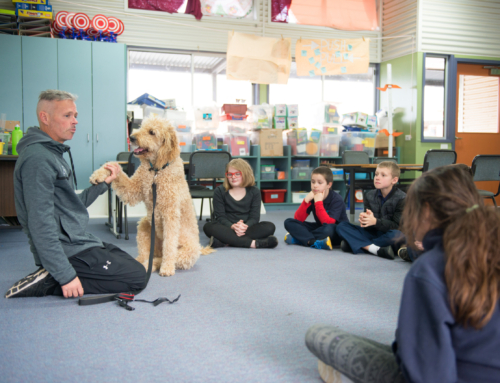The use of reading dogs in schools has gained significant attention in recent years as an innovative approach to improving students’ reading skills by helping students be more open to learning. Specially-trained pooches supply kids with a unique chance to hone their literacy abilities in an encouraging and unbiased atmosphere.
In this blog post, we will delve into the numerous benefits of incorporating well-being dogs in schools who in turn become helpful reading dogs in schools. We will also explore the scientific evidence supporting this method and its impact on student performance.
Finally, we will advise how to successfully introduce reading dogs into your school environment, allowing students and staff to reap the rewards of this educational program. Join us as we uncover the potential of reading dogs in transforming education for young learners.
Table of Contents:
- Benefits of Reading Dogs in Schools
- A Calming Presence for Students
- Promoting Emotional Regulation
- Better Focus and Concentration
- Social Skills Development
- How Reading Dogs Helps Students Learn
- Emotional Co-regulation
- Anxiety Reduction
- Increase Focus & Concentration
- Scientific Evidence for Reading Dogs in Schools
- The Science Behind Canine-Assisted Learning
- Dogs’ Impact on Emotional Regulation and Anxiety Reduction
- The Impact of Reading Dogs on Student Performance
- A. Enhanced Focus and Concentration
- B. Increased Confidence and Motivation
- C. Improved Social and Emotional Skills
- D. Positive Effects on Students with Special Needs
- How to Introduce Reading Dogs into Your School
- A. Assessing the Needs of Your School Community
- B. Researching Suitable Dog Breeds and Training Programs
- C. Developing Policies and Procedures
- FAQs in Relation to Reading Dogs in Schools
- What are the benefits of having reading dogs in schools?
- How do reading dogs help children with learning disabilities?
- Are there any risks associated with bringing reading dogs into classrooms?
- How does a school go about selecting and training a reading dog?
- What kind of impact can reading dogs have on student engagement and academic performance?
- Conclusion
To Learn More About Our Dog Connect Program For Your School Contact Us.
Benefits of Reading Dogs in Schools
Integrating well-being dogs into school environments can have a significant positive impact on students’ learning experiences. These well-trained and friendly canine companions provide numerous benefits to children, especially when it comes to improving their reading skills and can otherwise be called reading dogs which is how we will refer to them in this blog. Let’s explore some of the key advantages that come with having reading dogs in schools.
A Calming Presence for Students
The presence of a canine companion can provide students with an atmosphere conducive to reducing stress and anxiety associated with public speaking or performance pressure. Having a canine companion in the classroom encourages children to read aloud with ease, as they feel less anxious due to the presence of an accepting and non-judgmental listener. This is because the presence of a non-judgmental listener helps reduce anxiety levels associated with public speaking or performance pressure. As a result, students become more comfortable practicing their reading skills without fear of being criticized or judged by peers or teachers.
Promoting Emotional Regulation
The presence of reading dogs also promotes emotional regulation among students. By interacting with these gentle animals, children learn how to co-regulate their emotions naturally through the autonomic nervous system (ANS). This process allows them to move from an anxious state towards feeling calm and settled during classroom activities such as children read.
Better Focus and Concentration
- Increase Attention Span: A calmer environment created by the presence of reading dogs enables students to focus better on tasks at hand.
- Fewer Distractions: With reduced stress levels due to interaction with dogs, students find it easier not only concentrate but also stay engaged throughout lessons.
- Improved Memory Retention: A relaxed state of mind enhances students’ ability to absorb and retain information, leading to better academic performance.
Social Skills Development
Beyond the direct impact on reading skills, having dogs in schools also contributes to social skill development among children. Interacting with these friendly animals encourages communication, empathy, and teamwork – all essential life skills that extend beyond the classroom setting. Furthermore, by sharing their experiences with classmates or discussing how they feel when reading to a dog, students develop stronger bonds and connections within their peer groups.
Incorporating reading dogs into school programs can lead to significant improvements in student well-being and academic success. By providing a calming presence that promotes emotional regulation while enhancing focus and concentration levels, these canine companions play an invaluable role in creating positive learning environments for children of all ages.
The benefits of reading dogs in schools are numerous and can have a positive impact on student learning. With this knowledge, we now move on to exploring how these four-legged friends help students learn more effectively.
Key Thought: Having a pup nearby can bring about considerable benefits for students’ education, creating an affable atmosphere that allows them to practice reading without being judged. With the calming presence of these friendly animals, children benefit from improved attention span, reduced distractions and better memory retention while developing important social skills in the process.
How Reading Dogs Helps Students Learn
Reading dogs play a crucial role in helping students learn by creating a comfortable and supportive environment. They help children develop their reading skills, enhance emotional well-being, and improve overall academic performance. Let’s explore the various ways reading dogs contribute to student learning.
Emotional Co-regulation
Canines possess a natural capacity to detect human emotions and react suitably. When students interact with reading dogs, they experience emotional co-regulation, which helps them feel more relaxed and focused on their studies. This natural process allows children to lower their emotional barriers without feeling judged or confronted, making it easier for them to engage in learning activities such as children read.
Anxiety Reduction
Research has shown that interacting with animals can significantly reduce anxiety levels in humans. By having a calm and friendly dog present during reading sessions, students are likely to feel less anxious about their abilities or any challenges they may face while learning.
Increase Focus & Concentration
The presence of a reading dog can also help increase focus and concentration among students. As the classroom atmosphere becomes more relaxed due to the dog’s calming influence, children find it easier to concentrate on tasks at hand without being distracted by external factors.
Tips for Implementing Reading Dog Programs:
- Select suitable breeds: Choose therapy-trained dogs that are known for their gentle temperament and good behavior around children.
- Create designated spaces: Set up specific areas within your school where interactions between students and reading dogs can take place comfortably.
- Establish guidelines: Develop clear rules and expectations for students, staff, and dog handlers to ensure a safe and positive experience for all involved.
- Monitor progress: Regularly assess the impact of reading dogs on student learning by tracking academic performance, attendance rates, and overall well-being.
Incorporating reading dogs into your school’s curriculum can lead to numerous benefits for both students and educators. By understanding how these furry companions contribute to improved emotional regulation, reduced anxiety levels, increased focus, and enhanced learning experiences among children read sessions become more effective in promoting academic success.
Reading dogs in schools can provide students with a calming presence, help to reduce anxiety and stress levels, and increase engagement. This scientific evidence supports the use of reading dogs as an effective educational tool for improving student learning outcomes. Next we will explore how this research has been used to inform best practices when introducing reading dogs into classrooms.
Key Thought: Reading dogs provide an invaluable service in the classroom, helping to regulate emotions, reduce anxiety and improve concentration. They create a relaxed atmosphere which encourages students to engage with their learning material more effectively; making reading sessions far more successful for everyone involved.
3. Scientific Evidence for Reading Dogs in Schools
Evidence of the beneficial effects on student learning and well-being due to reading dogs in schools is increasingly documented. The presence of these specially trained canine companions has been shown to reduce stress levels, improve focus, and increase engagement with learning activities.
The Science Behind Canine-Assisted Learning
Studies have been conducted to examine the potential effects of dogs on kids’ cognitive growth and emotional control. One such study found that students who read aloud to a dog experienced significant improvements in their reading skills, as well as increased motivation to engage with literacy tasks.
Another research conducted by The University of British Columbia revealed that therapy dog sessions resulted in reduced stress levels among university students during exam periods, demonstrating how this calming effect extends beyond younger learners.
Dogs’ Impact on Emotional Regulation and Anxiety Reduction
- Anxiety reduction: A study published in the Journal of Clinical Child & Adolescent Psychology showed that children who interacted with a therapy dog before undergoing psychological testing exhibited significantly lower anxiety levels compared to those without canine interaction (source). This finding suggests that having a reading dog present may help alleviate test-related anxiety among students.
- Social-emotional benefits: Research from Tufts University demonstrated how children who participated in a reading dog program experienced increased empathy, self-esteem, and social skills (source). These benefits extend beyond the classroom and can have lasting effects on students’ overall well-being.
- Improved focus: The calming presence of a dog has been shown to help children with attention deficit hyperactivity disorder (ADHD) maintain better focus during learning activities. A study published in the Journal of Attention Disorders found that therapy dogs significantly improved attention and social behavior among children with ADHD (source).
In light of these findings, it is clear that incorporating reading dogs into educational settings can provide numerous advantages for students both academically and emotionally. By reducing anxiety levels and fostering emotional regulation, these canine companions create an optimal environment for learning.
Scientific evidence has shown that reading dogs in schools can have a positive impact on student performance and wellbeing. As such, it is important to understand the potential impacts of having reading dogs in classrooms on students’ academic outcomes.
Key Thought: Reading dogs have been scientifically proven to reduce stress levels, improve focus and engagement in learning activities, as well as increase empathy, self-esteem and social skills among students. This “canine companion” approach creates a calm environment for children to thrive academically and emotionally – allowing them to hit the ground running.
4. The Impact of Reading Dogs on Student Performance
Integrating reading dogs into the educational environment has shown to have a positive impact on student performance, particularly in the development of reading skills. This is due to several factors that contribute to creating an optimal learning atmosphere for children.
A. Enhanced Focus and Concentration
The calming presence of a dog can help students maintain their focus and concentration during reading sessions. Participants who read to an understanding and impartial audience such as a dog displayed more ease and fewer distractions from external sources or anxieties. A study conducted by Tufts University found that participants who read with therapy dogs demonstrated improved attention spans compared to those without canine companionship.
B. Increased Confidence and Motivation
Dogs provide unconditional support and encouragement, which helps boost students’ confidence when it comes to reading out loud or tackling challenging texts. As children become more comfortable with their reading skills,, they are also more motivated to engage in independent reading activities outside the classroom setting (source).
- Increase in fluency: Students who participate in programs involving reading dogs often show significant improvements in their overall fluency rates over time.
- Better comprehension: With increased confidence, motivation, and focus levels, students are better equipped to understand complex materials as well as retain information from what they’ve read.
C. Improved Social and Emotional Skills
Reading dogs not only help students academically but also contribute to the development of essential social and emotional skills. Interacting with a dog can teach children empathy, patience, and responsibility – all crucial life skills that extend beyond the classroom walls (source).
D. Positive Effects on Students with Special Needs
Students who have special needs or face learning challenges often benefit greatly from reading dog programs as well (source). The non-threatening presence of a canine companion can be particularly helpful for those struggling with anxiety or attention disorders, allowing them to relax and focus more effectively during reading sessions.
Incorporating reading dogs into educational settings has proven to be an effective strategy in enhancing student performance across various aspects – from academic achievements to personal growth and development.
The impact of reading dogs on student performance has been shown to be overwhelmingly positive, and introducing them into the classroom can provide a calming presence for students that will help improve their focus and overall learning experience. Moving forward, we’ll explore how to introduce these four-legged friends into your school environment.
Key Thought: Reading dogs have been shown to provide students with a calming presence, helping them maintain focus and build confidence while reading. As a result, children demonstrate improved fluency, comprehension, social and emotional skills as well as positive effects on those with special needs – making this strategy an effective tool for enhancing student performance in the classroom.
5. How to Introduce Reading Dogs into Your School
Introducing reading dogs into your school can be a rewarding experience for both students and staff, but it requires careful planning and consideration of everyone’s needs. To ensure successful implementation of a reading dog program, one must assess the needs of their school community.
A. Assessing the Needs of Your School Community
Before introducing a reading dog program, it is essential to assess the needs of your school community. This includes understanding how such an initiative would benefit students with different learning styles and abilities, as well as considering any potential challenges or concerns from parents and staff members.
B. Researching Suitable Dog Breeds and Training Programs
Not all dogs are suitable for working in schools; therefore, researching appropriate breeds that have been proven effective in assisting children with their reading skills is crucial. Additionally, finding reputable training programs that specialize in preparing dogs for work within educational settings is essential for ensuring success.
- Making sure the wellbeing of your school dog is thoroughly planned for.
It is crucial that schools work towards making sure that all relevant animal wellbeing standards and guidelines are reflective in every level of implementing an initiative such as reading dogs or wellbeing dogs. This can be tricky to negotiate but it must be demonstrated so that the inclusion of dogs can be not only successful, but meaningful and positive for the dogs as well as the humans.
C. Developing Policies and Procedures
In order to maintain safety standards while incorporating reading dogs into your school environment, clear policies and procedures must be established beforehand. These should cover topics such as:
- Dog selection criteria
- Vaccination requirements
- Scheduling considerations
- Allergen management strategies
- Risk assessments
FAQs in Relation to Reading Dogs in Schools
What are the benefits of having reading dogs in schools?
Having reading dogs in schools has been proven to be beneficial for both students and teachers. Research has indicated that the presence of a furry friend can assist in minimizing tension, enhancing attention, stimulating socialization and reinforcing self-confidence among students. Dogs also provide an unconditional listening ear which helps children feel more comfortable while reading aloud. This allows them to take their time without feeling rushed or judged by others. Furthermore, having a dog in the classroom can create an atmosphere of calmness and security which encourages learning and engagement with material being taught. Ultimately, the presence of a reading dog in schools can provide numerous benefits for students and teachers alike.
How do reading dogs help children with learning disabilities?
Canines can assist children with learning disabilities by exuding a tranquilizing and reassuring atmosphere, which assists in alleviating tension and worry. The act of reading aloud to the dog also helps improve literacy skills, as well as self-confidence and socialization. Studies have shown that having a therapy dog present in classrooms has improved student engagement, focus, cooperation, communication skills, comprehension levels and overall academic performance for students with learning disabilities. Additionally, these same studies show that interactions between children with special needs and trained therapy dogs result in decreased feelings of loneliness or isolation while promoting emotional stability which is essential for successful learning outcomes.
Are there any risks associated with bringing reading dogs into classrooms?
The risks associated with bringing reading dogs into classrooms are minimal. Dogs must be carefully screened for health and temperament before being allowed to interact with students. Handlers should also be trained in proper dog handling techniques, including safe interactions between the animal and children. Finally, strict hygiene protocols should be followed when dealing with any animals within a school setting to ensure that no illnesses or diseases are spread among students or staff members. With these precautions in place, the risk of harm from introducing reading dogs into classrooms is negligible.
How does a school go about selecting and training a reading dog?
Selecting and training a reading dog requires careful consideration. Schools should seek out canines that are tranquil, affable, self-assured, compliant and possess commendable social capabilities. They must also be of the right size to fit comfortably in the classroom environment. Once a suitable pup has been chosen, schools can enlist the aid of experienced trainers to assess its suitability and give advice on how best to educate it for its new job. This includes teaching basic commands such as sit/stay/down but also more specific tasks related to helping children read aloud or even just providing companionship during quiet time activities. With the right training, these dogs can be a wonderful addition to any school.
What kind of impact can reading dogs have on student engagement and academic performance?
Research has indicated that introducing canines to the learning environment can positively influence student engagement and scholastic achievement. Studies suggest that when students interact with reading dogs, they become more engaged in the learning process and tend to focus better on their tasks. Moreover, these interactions have been observed to result in higher levels of communication proficiency and greater sympathy for others. Reading dogs also help create an environment of trust which encourages students to take risks while exploring new ideas or concepts. As a result, this can improve overall academic performance as well as social-emotional development among students of all ages.
Conclusion
Reading dogs in schools can be an invaluable asset for helping students learn and reach their potential. The calming presence of a reading dog has been scientifically proven to reduce anxiety, increase focus, and create meaningful connections between the student and the material being studied. Schools that have adopted this program have experienced enhanced performance from their students, as well as more enthusiasm towards learning activities. Reading dogs are a great way to help promote positive academic outcomes while providing comfort and companionship to those who need it most.
To Get Started With Our Dog Connect Program For Your School Contact Us.







